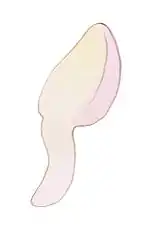Priscansermarinus
Priscansermarinus barnetti is an organism known from the Middle Cambrian Burgess Shale which was originally interpreted as a species of lepadomorph barnacle.[1] Four specimens of P. barnetti are known from the Greater Phyllopod bed.[2] A reflective area originally interpreted as external plates has been reinterpreted as a more complex structure inside the body; Derek Briggs, a leading authority on the arthropods of the Burgess Shale,[3] has questioned its assignment as a barnacle or even an arthropod. Its taxonomic status is uncertain.[4]
| Priscansermarinus | |
|---|---|
 | |
| Scientific classification | |
| Kingdom: | |
| Phylum: | |
| Class: | |
| Order: | |
| Family: | Cyprilepadidae |
| Genus: | Priscansermarinus Collins & Rudkin, 1981 |
| Species: | P. barnetti |
| Binomial name | |
| Priscansermarinus barnetti Collins & Rudkin, 1981 | |
References
- Desmond Collins & David M. Rudkin (1981). "Priscansermarinus barnetti, a probable lepadomorph barnacle from the Middle Cambrian Burgess Shale of British Columbia". Journal of Paleontology. 55 (5): 1006–1015. JSTOR 1304526.
- J. B. Caron & D. A. Jackson (2006). "Taphonomy of the Greater Phyllopod Bed community, Burgess Shale". Palaios. 21 (5): 451–465. doi:10.2110/palo.2003.P05-070R.
- "DServe Archive Catalog Show". collections.royalsociety.org. Retrieved 2018-10-27.
- "The Burgess Shale". burgess-shale.rom.on.ca. Royal Ontario Museum. 2011-06-10. Retrieved 2018-10-27.
External links
- "Priscansermarinus barnetti". Burgess Shale Fossil Gallery. Virtual Museum of Canada. 2011.
This article is issued from Wikipedia. The text is licensed under Creative Commons - Attribution - Sharealike. Additional terms may apply for the media files.